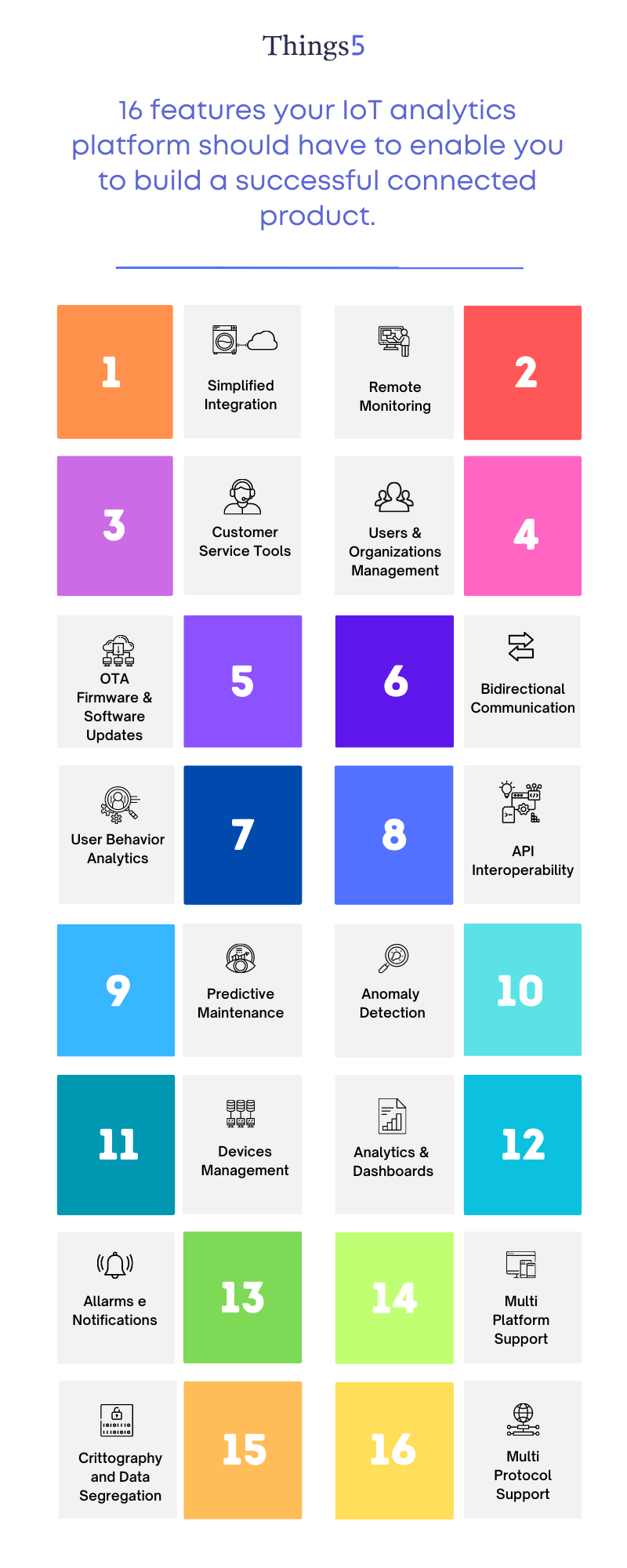16 features that your IoT analytics platform should have to enable you to build a successful connected product.

Daniele Delle Case
Published: March 23, 2022
The Internet of Things (IoT) has revolutionized the way we interact with our everyday objects, from smart products to connected cars. An IoT analytics platform is a critical component of any IoT project, as it allows you to collect, analyze, and interpret data from connected devices. This article contains some of the lessons learned from years of collaborations with dozens of companies, which have allowed us to develop a comprehensive and reliable IoT platform. We will discuss the features of a successful IoT analytics platform for smart products and the benefits it can provide. We will also examine the trade-offs involved in balancing different factors and the challenges associated with various solutions. Finally, we will discuss the importance of considering the impact when making decisions about selecting the right IoT analytics platform.

What is an IoT Analytics Platform?
An IoT analytics platform is a software solution that enables businesses to collect, store, and analyze data from connected devices. It allows companies to gain insights into customer behaviors, monitor device performance, and automate decisions. It also helps businesses detect and mitigate potential security risks, improve predictive maintenance, and develop targeted marketing campaigns.
Why is choosing the right platform important?
Choosing the right IoT analytics platform is essential for any IoT project, as it can help ensure the project's success and provide the necessary information for making informed decisions. A good platform should be tailored to the specific needs of the project, provide real-time data collection and analysis, and offer secure data storage. It should also provide features that enable remote fault detection, monitoring, and service, as well as automated alerts and notifications.
Start with the IoT platform that will make you fall in love with your data. Try things5 today.
Features an IoT Analytics Platform for Smart Products Must Have
When choosing an IoT analytics platform for smart products, it is important to consider the available features. A successful platform should have the ability to collect and analyze data in real-time, detect faults and monitor devices, provide automated alerts and notifications, and understand user behavior. It should also include the ability to customize dashboards, securely store data in the cloud, connect to multiple devices, provide targeted software updates, offer intelligent recommendations, and support multiple platforms. Additionally, the platform should have the ability to detect anomalies, make automated decisions based on data, utilize machine learning and AI, and integrate with third-party systems. All these features are crucial to ensure that businesses can get the most out of their IoT analytics platform and make the best possible decisions.
1. Simplified Integration
A Simplified Integration system is one of the main features an IoT analytics platform must have to enable manufacturers to build a successful connected product. Simplified integration makes the device usage experience less complex for the end-user. With simplified integration, the user can easily connect the device to their home network, allowing them to use all the services and features offered by the device. Moreover, simplified integration allows device manufacturers to add new features without requiring any intervention from the end-user. This means that users can use the device without worrying about manually installing or updating drivers or management software. Additionally, simplified integration can also enable manufacturers to reduce the overall cost of the device by allowing for faster product deployment in the market. In this way, manufacturers can offer a higher quality product at a lower cost, increasing user satisfaction and helping to build a successful connected product.
2. Remote Monitoring
Remote Monitoring is one of the most important features an IoT analytics platform must have to build a successful connected product. Remote monitoring allows tracking connected devices and obtaining information about the device's status, performance, and usage. This type of monitoring is crucial to ensure that devices behave as expected and can quickly respond to changes in the environment. Additionally, remote monitoring can be used to provide real-time diagnostic data, such as device temperature, connection speed, network performance, and more. This type of monitoring can also be used to detect any anomalies and prevent future problems. Remote monitoring can also help an organization optimize device performance, as it allows identifying any issues in advance and resolving them before they impact service quality. In summary, remote monitoring provides a detailed view of connected device usage and performance and is an essential tool for building successful connected products.
3. Remote Customer Service
An IoT analytics platform with the ability to troubleshoot and launch procedures remotely provides an excellent way to keep up with device performance. This feature allows businesses to quickly detect and resolve any issues with connected devices, avoiding costly downtime. Additionally, it can be used to launch remote maintenance procedures and updates, eliminating the need for manual intervention. This type of remote service is an essential feature of any successful IoT analytics platform for smart products.
4. User and Organization Management
A successful IoT analytics platform must be able to easily manage users and organizations. User management should include the ability to create accounts, manage permissions and credentials, manage account settings and personal information. Organization management should include the ability to create groups, manage permissions and credentials, manage organization settings and personal information. Additionally, the platform should provide customer service tools to manage user and organization requests. These tools should include the ability to manage requests, answer questions, and provide technical support.
5. Firmware and Software Batch Updates
The ability to provide targeted software updates with an Over the Air approach is an important feature of a successful IoT analytics platform for smart products. This feature allows companies to remotely perform software updates on connected devices in a timely manner, ensuring that all connected devices are up-to-date and secure. This capability can save time and money on manual updates and reduce the risk of security breaches due to outdated software. In addition, targeted software updates allow companies to customize the software they provide to their customers, ensuring they receive the most relevant updates for their device.
6. Bidirectional Communication
Bidirectional communication is one of the most important features that an IoT analytics platform must have to build a successful connected product. Bidirectional communication allows connected devices to send and receive data in real-time, enabling greater interaction between device and user. This means that devices can be remotely controlled and can also send notifications to the user. In addition, bidirectional communication allows for real-time data collection, which can be used to analyze user behavior and make more informed decisions. Bidirectional communication is an essential feature for creating successful connected products, as it allows for a more engaging and interactive user experience.
7. User Behavior Analysis
The ability to understand how users interact with connected products is an important feature of a successful IoT analytics platform. By collecting data from connected devices, companies can gain insights into user behavior and understand how customers use their products. This data can be used to identify customer preferences, develop targeted marketing campaigns, and improve product performance. In addition, understanding user behavior can help companies identify potential issues and take appropriate measures to ensure customer satisfaction.
8. Interoperability
Interoperability is an essential feature for any IoT analytics platform for smart products. It allows for the integration of third-party systems and applications, making it easier to access, analyze, and manage data from connected devices. In addition, with interoperability, companies can easily create custom applications and services that can be used with their existing infrastructure. Interoperability offers numerous benefits to companies, including improved customer experience, increased efficiency, cost savings, and improved security.
9. Predictive Maintenance
Predictive maintenance is one of the most important features that an IoT analytics platform must have to build a successful connected product. Predictive maintenance allows predicting problems before they occur, thus reducing downtime and maintenance costs. The IoT analytics platform must be able to collect and analyze data from connected devices to identify problems in advance and provide a quick solution. Additionally, the platform must be able to provide a real-time overview of data to enable quick problem resolution. Predictive maintenance is an essential feature for building a successful connected product as it helps prevent problems before they occur.
10. Anomaly Detection
Anomaly detection is an important feature of any successful IoT analytics platform for intelligent products. Anomaly detection allows companies to detect anomalies in data sets, which can be a sign of a potential problem. This helps companies quickly identify any issues and take corrective actions. Additionally, anomaly detection can help companies identify trends or patterns in data for further improvements to their products and services.
11. Connectivity and Device Management
The ability to connect to multiple devices and networks for comprehensive data analysis is an essential feature of a successful IoT analytics platform for intelligent products. It allows companies to track, monitor, and analyze data from multiple devices in real-time and helps them make better decisions. This feature also allows companies to create a unified view of how their products are performing across multiple networks and helps them identify opportunities for improvement. Additionally, it can help them manage and protect their data from potential security threats. Furthermore, this feature can be used to create automatic alerts and notifications to users when certain conditions are met.
12. Analytics and Dashboards
Dashboards are a fundamental tool for managing data in an IoT analytics platform. Dashboards allow data to be displayed intuitively and monitor device performance in real-time. Dashboards can be customized based on user needs and can be used to analyze data more in-depth. Additionally, dashboards can be used to create detailed reports on data collected from devices. This allows identifying trends and anomalies in data, as well as making informed decisions on how to optimize device performance. Dashboards can also be used to create charts and diagrams that help better understand data. Furthermore, dashboards can be used to create alarms and notifications in case of data anomalies.
13. Automated Alarms and Notifications
Automated real-time alarms and notifications are an important feature of a successful IoT analytics platform for smart products, as they allow users to receive automated alerts and notifications when certain conditions are met. This can be extremely useful for users, as it allows them to be aware of any potential issues with their connected devices, as well as any changes in performance or settings. Additionally, this feature can help users take proactive measures to ensure that their connected devices are functioning properly at all times. This feature can also be used to alert users of any new updates or features available, helping them stay up-to-date with the latest developments.
14. Multi-Platform Support
The ability to support multiple platforms such as web, mobile, and desktop is a key feature of a successful IoT analytics platform for smart products. By having multi-platform support, companies can ensure that their data is accessible and usable on a variety of devices and systems. This allows companies to provide a unified user experience that customers can access from any device. Additionally, multi-platform support allows companies to quickly update their systems and applications with the latest software and features, ensuring their customers have the best possible experience.
15. Data Encryption and Segregation
Encryption is a security technique that helps protect sensitive data from unauthorized access. Data segregation, on the other hand, is a technique that helps separate sensitive data from non-sensitive data. A successful IoT analytics platform must be able to provide reliable data encryption and segregation. Encryption must be able to protect sensitive data from unauthorized access, while data segregation must be able to separate sensitive data from non-sensitive data. Additionally, the platform must be able to securely manage encryption keys and provide end-to-end encryption. Encryption and data segregation are critical to ensuring data security and user privacy.
16. Multi-Protocol Support
Multi-protocol support is one of the most important features that an IoT analytics platform should have to build a successful connected product. Multi-protocol support allows devices to communicate with each other using different communication protocols, such as MQTT, HTTPS, Bluetooth, Wi-Fi, Zigbee, Z-Wave, etc. This means that devices can be easily integrated with the IoT analytics platform, regardless of the communication protocol used. Additionally, multi-protocol support allows for the best use of connected device features, such as connectivity, security, scalability, and data management. In summary, multi-protocol support is an essential feature for the IoT analytics platform, as it allows for the best use of connected device features and easy integration of devices with the platform.
Conclusion
In conclusion, a successful IoT analytics platform for smart products must have the following functionalities: real-time data collection and analysis, remote fault detection and monitoring, remote customer service, automated alarms and notifications, user behavior analysis, dashboard customization, scalability, secure data storage, device connectivity and management, batch updates, and intelligent recommendations. These functionalities are essential to ensure that companies can get the most out of their IoT analytics platform and make the best possible decisions. Thanks to these functionalities, companies can efficiently monitor, analyze, and manage their connected products, ensuring optimal customer satisfaction.
The Things5 platform provides a comprehensive solution for managing IoT devices, encompassing all the functionalities outlined in the article. This enables efficient and secure management of the entire device lifecycle, making Things5 the ultimate solution for device management and IoT data enhancement. With Things5, launching your IoT project is hassle-free. Request a Things5 demo today and unlock the full potential of the Internet of Things.
Start with the IoT platform that will make you fall in love with your data. Try Things5 today.

USEFUL LINKS
SUBSCRIBE TO OUR NEWSLETTER
You need a helping hand with your project?
We will get back to you as soon as possible
Please try again later
All Rights Reserved | Visup Srl | VAT: IT09299620964

